Analysis of Liquidation in Financial Accounting: Australian Cases
VerifiedAdded on 2021/06/17
|12
|2890
|19
Report
AI Summary
This report provides an in-depth analysis of liquidation in financial accounting, focusing on the cases of three prominent Australian companies: ABC Learning, One Tel, and HIH Insurance. The report begins by defining liquidation and its fundamental principles, highlighting the circumstances under which a company may face insolvency and the subsequent process of asset sale to satisfy liabilities. It then delves into the specifics of each company's liquidation, exploring the factors that led to their downfall, including accounting malpractices, non-compliance with corporate governance, poor management decisions, and inadequate internal controls. The analysis of ABC Learning reveals issues such as non-compliance with accounting policies, overpayment in acquisitions, and weak corporate governance. The One Tel case highlights fraudulent accounting practices, inflated sales projections, and excessive debt. HIH Insurance's liquidation is attributed to incorrect valuations, aggressive accounting, and inadequate due diligence in acquisitions. The report concludes by drawing parallels between the cases, emphasizing that liquidation is not solely caused by debt but also by a combination of factors like unethical practices, incompetent management, and failures in auditing. The report recommends that companies adopt robust internal controls, ethical practices, proper due diligence, and responsible financial reporting.

FINANCIAL
ACCOUNTING
ASSIGNMENT
ACCOUNTING
ASSIGNMENT
Paraphrase This Document
Need a fresh take? Get an instant paraphrase of this document with our AI Paraphraser
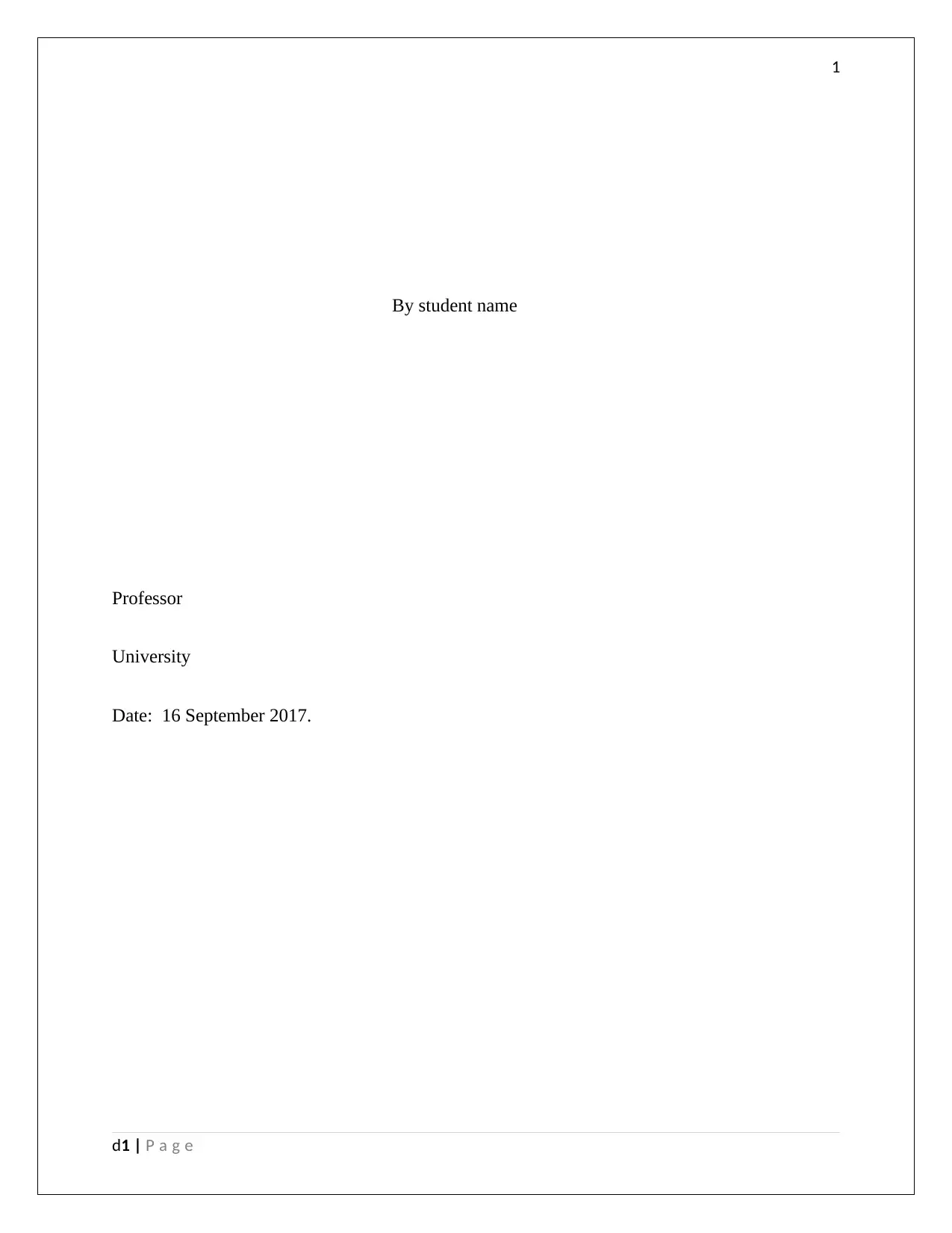
1
By student name
Professor
University
Date: 16 September 2017.
d1 | P a g e
By student name
Professor
University
Date: 16 September 2017.
d1 | P a g e
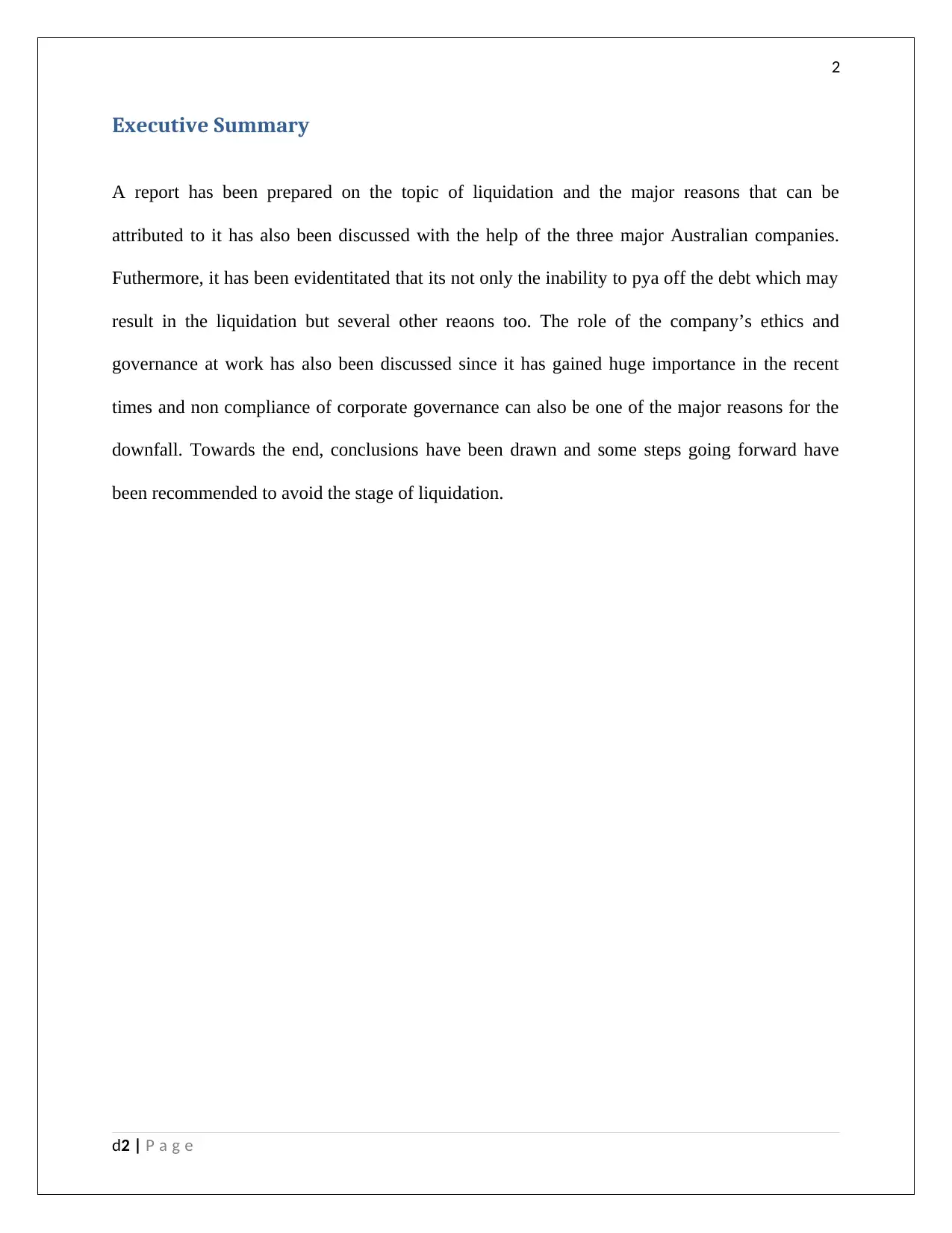
2
Executive Summary
A report has been prepared on the topic of liquidation and the major reasons that can be
attributed to it has also been discussed with the help of the three major Australian companies.
Futhermore, it has been evidentitated that its not only the inability to pya off the debt which may
result in the liquidation but several other reaons too. The role of the company’s ethics and
governance at work has also been discussed since it has gained huge importance in the recent
times and non compliance of corporate governance can also be one of the major reasons for the
downfall. Towards the end, conclusions have been drawn and some steps going forward have
been recommended to avoid the stage of liquidation.
d2 | P a g e
Executive Summary
A report has been prepared on the topic of liquidation and the major reasons that can be
attributed to it has also been discussed with the help of the three major Australian companies.
Futhermore, it has been evidentitated that its not only the inability to pya off the debt which may
result in the liquidation but several other reaons too. The role of the company’s ethics and
governance at work has also been discussed since it has gained huge importance in the recent
times and non compliance of corporate governance can also be one of the major reasons for the
downfall. Towards the end, conclusions have been drawn and some steps going forward have
been recommended to avoid the stage of liquidation.
d2 | P a g e
⊘ This is a preview!⊘
Do you want full access?
Subscribe today to unlock all pages.

Trusted by 1+ million students worldwide
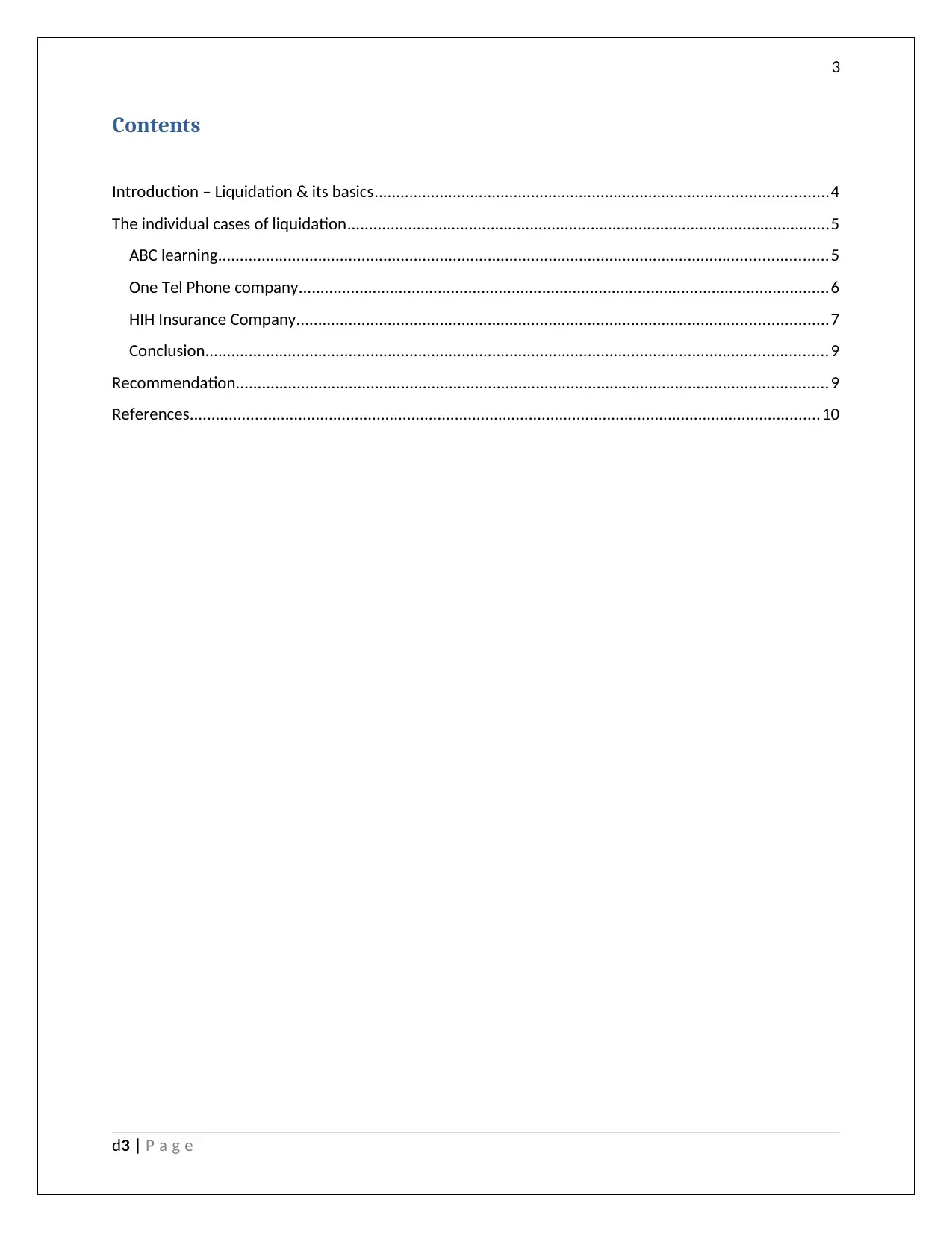
3
Contents
Introduction – Liquidation & its basics........................................................................................................4
The individual cases of liquidation...............................................................................................................5
ABC learning............................................................................................................................................5
One Tel Phone company..........................................................................................................................6
HIH Insurance Company..........................................................................................................................7
Conclusion...............................................................................................................................................9
Recommendation........................................................................................................................................9
References.................................................................................................................................................10
d3 | P a g e
Contents
Introduction – Liquidation & its basics........................................................................................................4
The individual cases of liquidation...............................................................................................................5
ABC learning............................................................................................................................................5
One Tel Phone company..........................................................................................................................6
HIH Insurance Company..........................................................................................................................7
Conclusion...............................................................................................................................................9
Recommendation........................................................................................................................................9
References.................................................................................................................................................10
d3 | P a g e
Paraphrase This Document
Need a fresh take? Get an instant paraphrase of this document with our AI Paraphraser
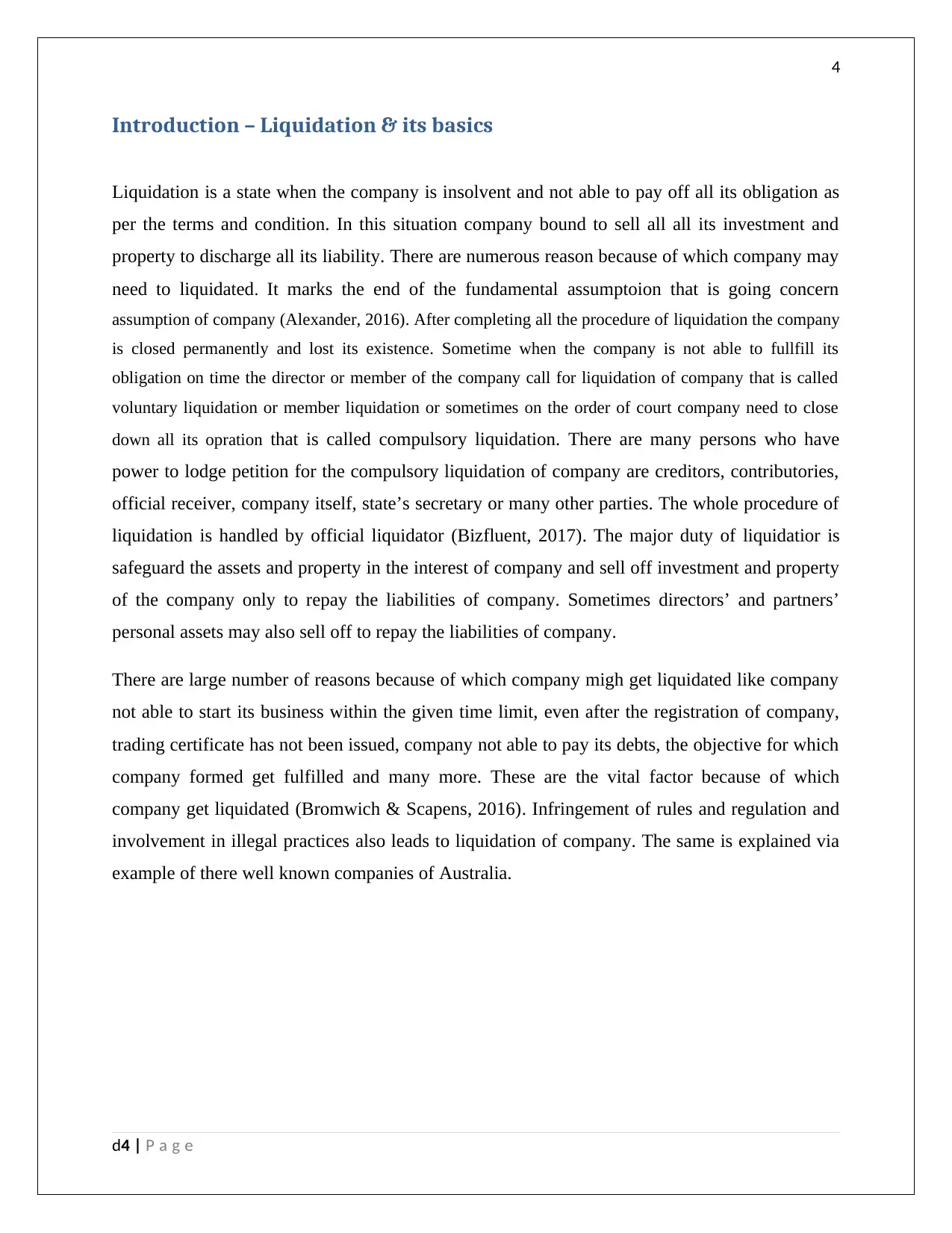
4
Introduction – Liquidation & its basics
Liquidation is a state when the company is insolvent and not able to pay off all its obligation as
per the terms and condition. In this situation company bound to sell all all its investment and
property to discharge all its liability. There are numerous reason because of which company may
need to liquidated. It marks the end of the fundamental assumptoion that is going concern
assumption of company (Alexander, 2016). After completing all the procedure of liquidation the company
is closed permanently and lost its existence. Sometime when the company is not able to fullfill its
obligation on time the director or member of the company call for liquidation of company that is called
voluntary liquidation or member liquidation or sometimes on the order of court company need to close
down all its opration that is called compulsory liquidation. There are many persons who have
power to lodge petition for the compulsory liquidation of company are creditors, contributories,
official receiver, company itself, state’s secretary or many other parties. The whole procedure of
liquidation is handled by official liquidator (Bizfluent, 2017). The major duty of liquidatior is
safeguard the assets and property in the interest of company and sell off investment and property
of the company only to repay the liabilities of company. Sometimes directors’ and partners’
personal assets may also sell off to repay the liabilities of company.
There are large number of reasons because of which company migh get liquidated like company
not able to start its business within the given time limit, even after the registration of company,
trading certificate has not been issued, company not able to pay its debts, the objective for which
company formed get fulfilled and many more. These are the vital factor because of which
company get liquidated (Bromwich & Scapens, 2016). Infringement of rules and regulation and
involvement in illegal practices also leads to liquidation of company. The same is explained via
example of there well known companies of Australia.
d4 | P a g e
Introduction – Liquidation & its basics
Liquidation is a state when the company is insolvent and not able to pay off all its obligation as
per the terms and condition. In this situation company bound to sell all all its investment and
property to discharge all its liability. There are numerous reason because of which company may
need to liquidated. It marks the end of the fundamental assumptoion that is going concern
assumption of company (Alexander, 2016). After completing all the procedure of liquidation the company
is closed permanently and lost its existence. Sometime when the company is not able to fullfill its
obligation on time the director or member of the company call for liquidation of company that is called
voluntary liquidation or member liquidation or sometimes on the order of court company need to close
down all its opration that is called compulsory liquidation. There are many persons who have
power to lodge petition for the compulsory liquidation of company are creditors, contributories,
official receiver, company itself, state’s secretary or many other parties. The whole procedure of
liquidation is handled by official liquidator (Bizfluent, 2017). The major duty of liquidatior is
safeguard the assets and property in the interest of company and sell off investment and property
of the company only to repay the liabilities of company. Sometimes directors’ and partners’
personal assets may also sell off to repay the liabilities of company.
There are large number of reasons because of which company migh get liquidated like company
not able to start its business within the given time limit, even after the registration of company,
trading certificate has not been issued, company not able to pay its debts, the objective for which
company formed get fulfilled and many more. These are the vital factor because of which
company get liquidated (Bromwich & Scapens, 2016). Infringement of rules and regulation and
involvement in illegal practices also leads to liquidation of company. The same is explained via
example of there well known companies of Australia.
d4 | P a g e
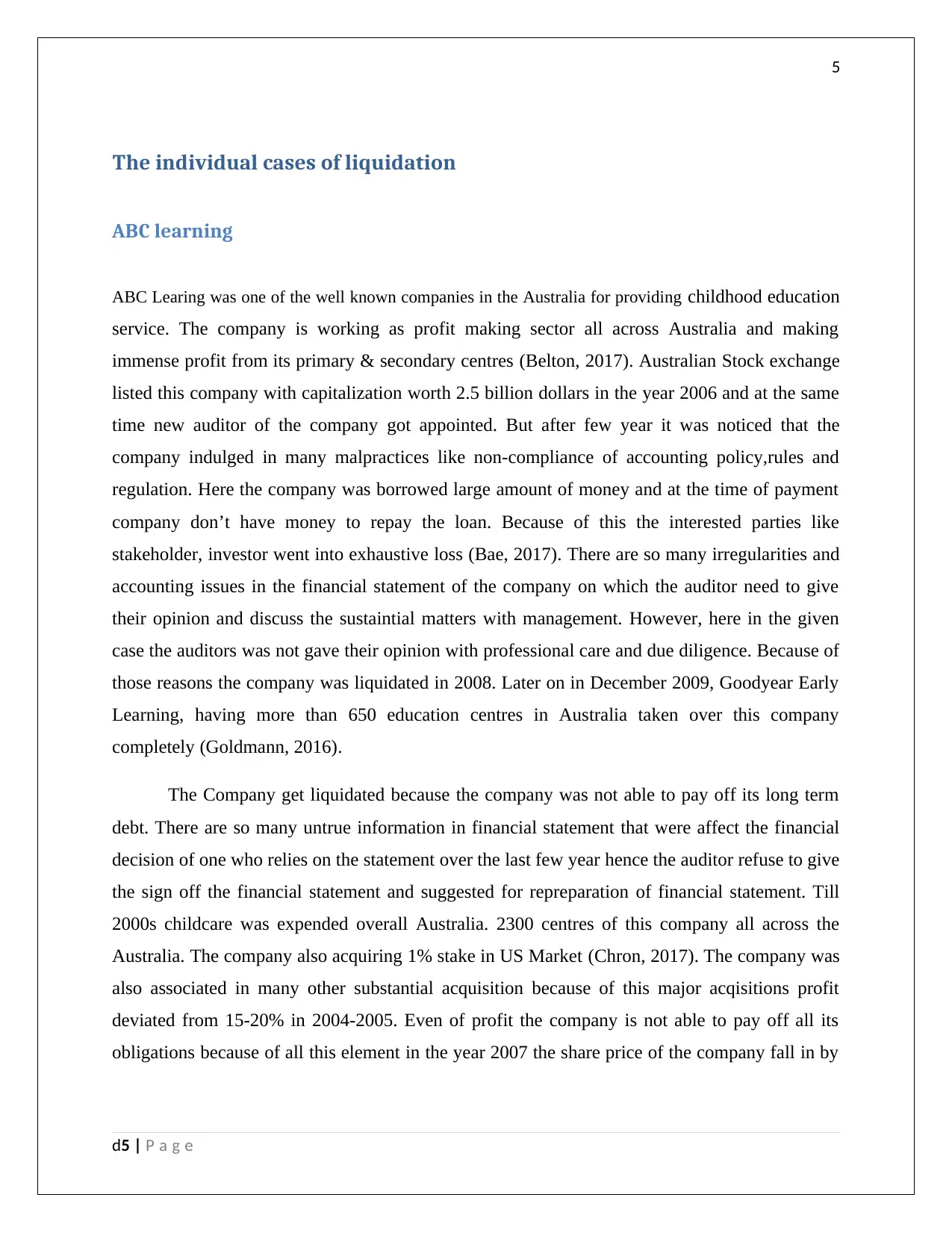
5
The individual cases of liquidation
ABC learning
ABC Learing was one of the well known companies in the Australia for providing childhood education
service. The company is working as profit making sector all across Australia and making
immense profit from its primary & secondary centres (Belton, 2017). Australian Stock exchange
listed this company with capitalization worth 2.5 billion dollars in the year 2006 and at the same
time new auditor of the company got appointed. But after few year it was noticed that the
company indulged in many malpractices like non-compliance of accounting policy,rules and
regulation. Here the company was borrowed large amount of money and at the time of payment
company don’t have money to repay the loan. Because of this the interested parties like
stakeholder, investor went into exhaustive loss (Bae, 2017). There are so many irregularities and
accounting issues in the financial statement of the company on which the auditor need to give
their opinion and discuss the sustaintial matters with management. However, here in the given
case the auditors was not gave their opinion with professional care and due diligence. Because of
those reasons the company was liquidated in 2008. Later on in December 2009, Goodyear Early
Learning, having more than 650 education centres in Australia taken over this company
completely (Goldmann, 2016).
The Company get liquidated because the company was not able to pay off its long term
debt. There are so many untrue information in financial statement that were affect the financial
decision of one who relies on the statement over the last few year hence the auditor refuse to give
the sign off the financial statement and suggested for repreparation of financial statement. Till
2000s childcare was expended overall Australia. 2300 centres of this company all across the
Australia. The company also acquiring 1% stake in US Market (Chron, 2017). The company was
also associated in many other substantial acquisition because of this major acqisitions profit
deviated from 15-20% in 2004-2005. Even of profit the company is not able to pay off all its
obligations because of all this element in the year 2007 the share price of the company fall in by
d5 | P a g e
The individual cases of liquidation
ABC learning
ABC Learing was one of the well known companies in the Australia for providing childhood education
service. The company is working as profit making sector all across Australia and making
immense profit from its primary & secondary centres (Belton, 2017). Australian Stock exchange
listed this company with capitalization worth 2.5 billion dollars in the year 2006 and at the same
time new auditor of the company got appointed. But after few year it was noticed that the
company indulged in many malpractices like non-compliance of accounting policy,rules and
regulation. Here the company was borrowed large amount of money and at the time of payment
company don’t have money to repay the loan. Because of this the interested parties like
stakeholder, investor went into exhaustive loss (Bae, 2017). There are so many irregularities and
accounting issues in the financial statement of the company on which the auditor need to give
their opinion and discuss the sustaintial matters with management. However, here in the given
case the auditors was not gave their opinion with professional care and due diligence. Because of
those reasons the company was liquidated in 2008. Later on in December 2009, Goodyear Early
Learning, having more than 650 education centres in Australia taken over this company
completely (Goldmann, 2016).
The Company get liquidated because the company was not able to pay off its long term
debt. There are so many untrue information in financial statement that were affect the financial
decision of one who relies on the statement over the last few year hence the auditor refuse to give
the sign off the financial statement and suggested for repreparation of financial statement. Till
2000s childcare was expended overall Australia. 2300 centres of this company all across the
Australia. The company also acquiring 1% stake in US Market (Chron, 2017). The company was
also associated in many other substantial acquisition because of this major acqisitions profit
deviated from 15-20% in 2004-2005. Even of profit the company is not able to pay off all its
obligations because of all this element in the year 2007 the share price of the company fall in by
d5 | P a g e
⊘ This is a preview!⊘
Do you want full access?
Subscribe today to unlock all pages.

Trusted by 1+ million students worldwide
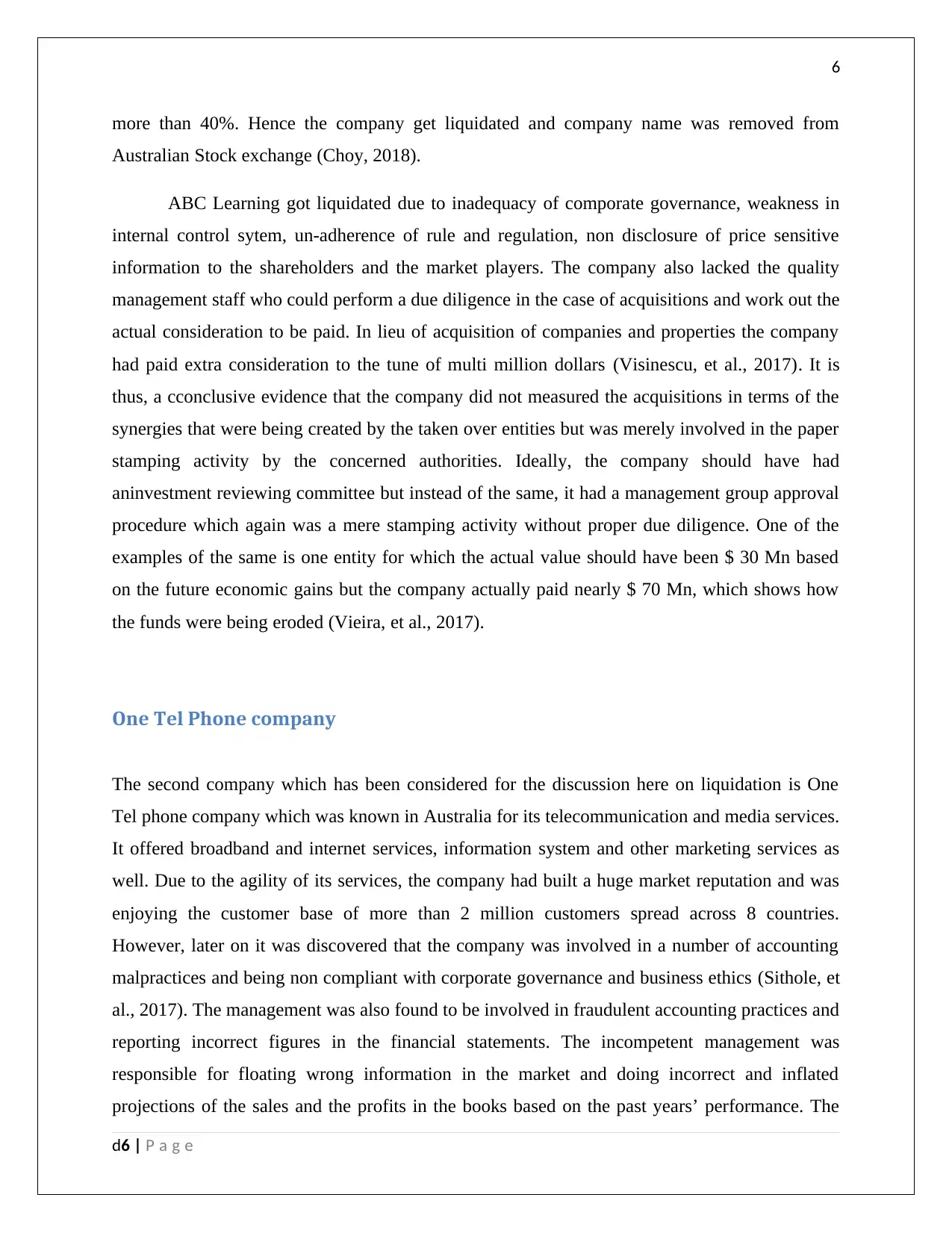
6
more than 40%. Hence the company get liquidated and company name was removed from
Australian Stock exchange (Choy, 2018).
ABC Learning got liquidated due to inadequacy of comporate governance, weakness in
internal control sytem, un-adherence of rule and regulation, non disclosure of price sensitive
information to the shareholders and the market players. The company also lacked the quality
management staff who could perform a due diligence in the case of acquisitions and work out the
actual consideration to be paid. In lieu of acquisition of companies and properties the company
had paid extra consideration to the tune of multi million dollars (Visinescu, et al., 2017). It is
thus, a cconclusive evidence that the company did not measured the acquisitions in terms of the
synergies that were being created by the taken over entities but was merely involved in the paper
stamping activity by the concerned authorities. Ideally, the company should have had
aninvestment reviewing committee but instead of the same, it had a management group approval
procedure which again was a mere stamping activity without proper due diligence. One of the
examples of the same is one entity for which the actual value should have been $ 30 Mn based
on the future economic gains but the company actually paid nearly $ 70 Mn, which shows how
the funds were being eroded (Vieira, et al., 2017).
One Tel Phone company
The second company which has been considered for the discussion here on liquidation is One
Tel phone company which was known in Australia for its telecommunication and media services.
It offered broadband and internet services, information system and other marketing services as
well. Due to the agility of its services, the company had built a huge market reputation and was
enjoying the customer base of more than 2 million customers spread across 8 countries.
However, later on it was discovered that the company was involved in a number of accounting
malpractices and being non compliant with corporate governance and business ethics (Sithole, et
al., 2017). The management was also found to be involved in fraudulent accounting practices and
reporting incorrect figures in the financial statements. The incompetent management was
responsible for floating wrong information in the market and doing incorrect and inflated
projections of the sales and the profits in the books based on the past years’ performance. The
d6 | P a g e
more than 40%. Hence the company get liquidated and company name was removed from
Australian Stock exchange (Choy, 2018).
ABC Learning got liquidated due to inadequacy of comporate governance, weakness in
internal control sytem, un-adherence of rule and regulation, non disclosure of price sensitive
information to the shareholders and the market players. The company also lacked the quality
management staff who could perform a due diligence in the case of acquisitions and work out the
actual consideration to be paid. In lieu of acquisition of companies and properties the company
had paid extra consideration to the tune of multi million dollars (Visinescu, et al., 2017). It is
thus, a cconclusive evidence that the company did not measured the acquisitions in terms of the
synergies that were being created by the taken over entities but was merely involved in the paper
stamping activity by the concerned authorities. Ideally, the company should have had
aninvestment reviewing committee but instead of the same, it had a management group approval
procedure which again was a mere stamping activity without proper due diligence. One of the
examples of the same is one entity for which the actual value should have been $ 30 Mn based
on the future economic gains but the company actually paid nearly $ 70 Mn, which shows how
the funds were being eroded (Vieira, et al., 2017).
One Tel Phone company
The second company which has been considered for the discussion here on liquidation is One
Tel phone company which was known in Australia for its telecommunication and media services.
It offered broadband and internet services, information system and other marketing services as
well. Due to the agility of its services, the company had built a huge market reputation and was
enjoying the customer base of more than 2 million customers spread across 8 countries.
However, later on it was discovered that the company was involved in a number of accounting
malpractices and being non compliant with corporate governance and business ethics (Sithole, et
al., 2017). The management was also found to be involved in fraudulent accounting practices and
reporting incorrect figures in the financial statements. The incompetent management was
responsible for floating wrong information in the market and doing incorrect and inflated
projections of the sales and the profits in the books based on the past years’ performance. The
d6 | P a g e
Paraphrase This Document
Need a fresh take? Get an instant paraphrase of this document with our AI Paraphraser
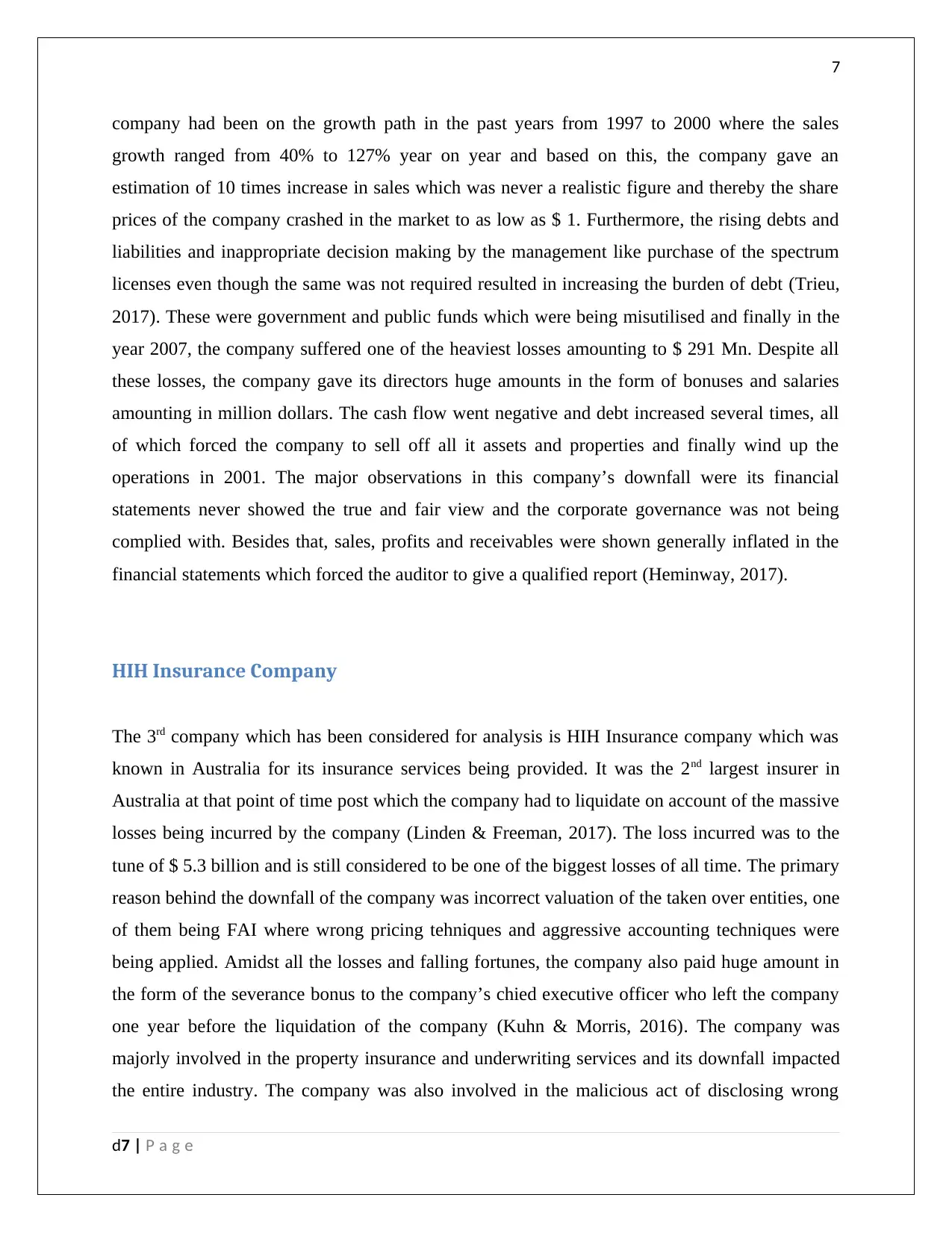
7
company had been on the growth path in the past years from 1997 to 2000 where the sales
growth ranged from 40% to 127% year on year and based on this, the company gave an
estimation of 10 times increase in sales which was never a realistic figure and thereby the share
prices of the company crashed in the market to as low as $ 1. Furthermore, the rising debts and
liabilities and inappropriate decision making by the management like purchase of the spectrum
licenses even though the same was not required resulted in increasing the burden of debt (Trieu,
2017). These were government and public funds which were being misutilised and finally in the
year 2007, the company suffered one of the heaviest losses amounting to $ 291 Mn. Despite all
these losses, the company gave its directors huge amounts in the form of bonuses and salaries
amounting in million dollars. The cash flow went negative and debt increased several times, all
of which forced the company to sell off all it assets and properties and finally wind up the
operations in 2001. The major observations in this company’s downfall were its financial
statements never showed the true and fair view and the corporate governance was not being
complied with. Besides that, sales, profits and receivables were shown generally inflated in the
financial statements which forced the auditor to give a qualified report (Heminway, 2017).
HIH Insurance Company
The 3rd company which has been considered for analysis is HIH Insurance company which was
known in Australia for its insurance services being provided. It was the 2nd largest insurer in
Australia at that point of time post which the company had to liquidate on account of the massive
losses being incurred by the company (Linden & Freeman, 2017). The loss incurred was to the
tune of $ 5.3 billion and is still considered to be one of the biggest losses of all time. The primary
reason behind the downfall of the company was incorrect valuation of the taken over entities, one
of them being FAI where wrong pricing tehniques and aggressive accounting techniques were
being applied. Amidst all the losses and falling fortunes, the company also paid huge amount in
the form of the severance bonus to the company’s chied executive officer who left the company
one year before the liquidation of the company (Kuhn & Morris, 2016). The company was
majorly involved in the property insurance and underwriting services and its downfall impacted
the entire industry. The company was also involved in the malicious act of disclosing wrong
d7 | P a g e
company had been on the growth path in the past years from 1997 to 2000 where the sales
growth ranged from 40% to 127% year on year and based on this, the company gave an
estimation of 10 times increase in sales which was never a realistic figure and thereby the share
prices of the company crashed in the market to as low as $ 1. Furthermore, the rising debts and
liabilities and inappropriate decision making by the management like purchase of the spectrum
licenses even though the same was not required resulted in increasing the burden of debt (Trieu,
2017). These were government and public funds which were being misutilised and finally in the
year 2007, the company suffered one of the heaviest losses amounting to $ 291 Mn. Despite all
these losses, the company gave its directors huge amounts in the form of bonuses and salaries
amounting in million dollars. The cash flow went negative and debt increased several times, all
of which forced the company to sell off all it assets and properties and finally wind up the
operations in 2001. The major observations in this company’s downfall were its financial
statements never showed the true and fair view and the corporate governance was not being
complied with. Besides that, sales, profits and receivables were shown generally inflated in the
financial statements which forced the auditor to give a qualified report (Heminway, 2017).
HIH Insurance Company
The 3rd company which has been considered for analysis is HIH Insurance company which was
known in Australia for its insurance services being provided. It was the 2nd largest insurer in
Australia at that point of time post which the company had to liquidate on account of the massive
losses being incurred by the company (Linden & Freeman, 2017). The loss incurred was to the
tune of $ 5.3 billion and is still considered to be one of the biggest losses of all time. The primary
reason behind the downfall of the company was incorrect valuation of the taken over entities, one
of them being FAI where wrong pricing tehniques and aggressive accounting techniques were
being applied. Amidst all the losses and falling fortunes, the company also paid huge amount in
the form of the severance bonus to the company’s chied executive officer who left the company
one year before the liquidation of the company (Kuhn & Morris, 2016). The company was
majorly involved in the property insurance and underwriting services and its downfall impacted
the entire industry. The company was also involved in the malicious act of disclosing wrong
d7 | P a g e
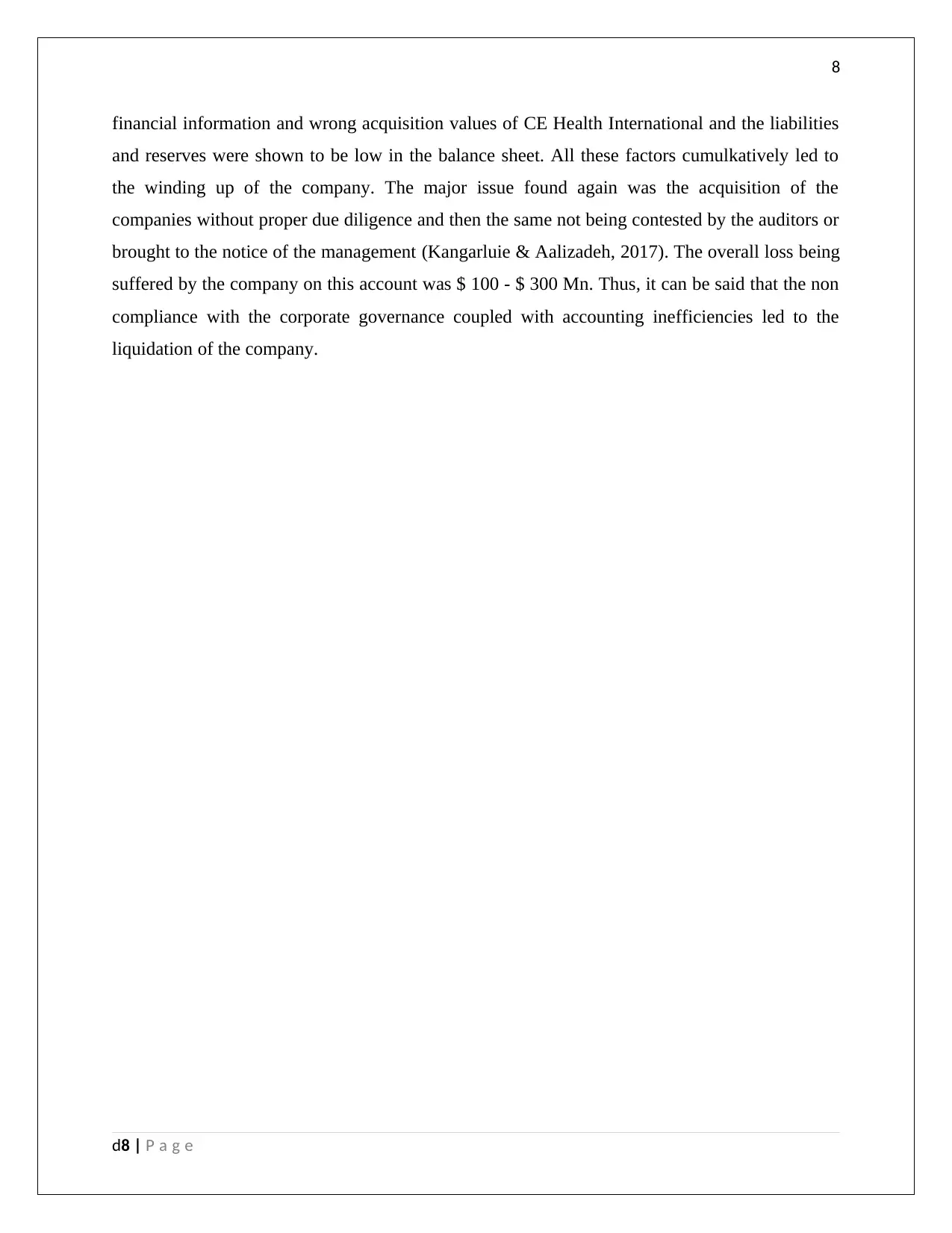
8
financial information and wrong acquisition values of CE Health International and the liabilities
and reserves were shown to be low in the balance sheet. All these factors cumulkatively led to
the winding up of the company. The major issue found again was the acquisition of the
companies without proper due diligence and then the same not being contested by the auditors or
brought to the notice of the management (Kangarluie & Aalizadeh, 2017). The overall loss being
suffered by the company on this account was $ 100 - $ 300 Mn. Thus, it can be said that the non
compliance with the corporate governance coupled with accounting inefficiencies led to the
liquidation of the company.
d8 | P a g e
financial information and wrong acquisition values of CE Health International and the liabilities
and reserves were shown to be low in the balance sheet. All these factors cumulkatively led to
the winding up of the company. The major issue found again was the acquisition of the
companies without proper due diligence and then the same not being contested by the auditors or
brought to the notice of the management (Kangarluie & Aalizadeh, 2017). The overall loss being
suffered by the company on this account was $ 100 - $ 300 Mn. Thus, it can be said that the non
compliance with the corporate governance coupled with accounting inefficiencies led to the
liquidation of the company.
d8 | P a g e
⊘ This is a preview!⊘
Do you want full access?
Subscribe today to unlock all pages.

Trusted by 1+ million students worldwide
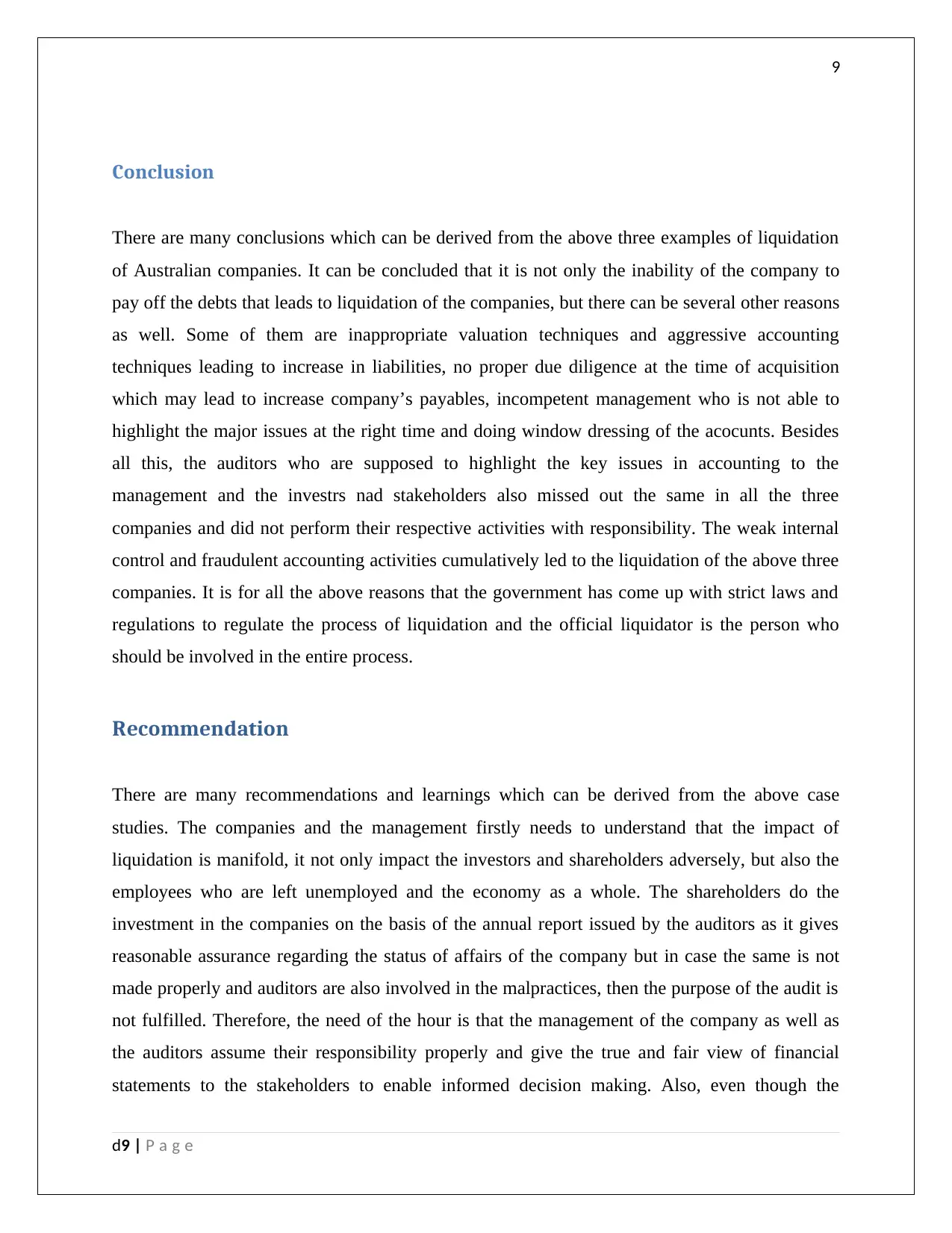
9
Conclusion
There are many conclusions which can be derived from the above three examples of liquidation
of Australian companies. It can be concluded that it is not only the inability of the company to
pay off the debts that leads to liquidation of the companies, but there can be several other reasons
as well. Some of them are inappropriate valuation techniques and aggressive accounting
techniques leading to increase in liabilities, no proper due diligence at the time of acquisition
which may lead to increase company’s payables, incompetent management who is not able to
highlight the major issues at the right time and doing window dressing of the acocunts. Besides
all this, the auditors who are supposed to highlight the key issues in accounting to the
management and the investrs nad stakeholders also missed out the same in all the three
companies and did not perform their respective activities with responsibility. The weak internal
control and fraudulent accounting activities cumulatively led to the liquidation of the above three
companies. It is for all the above reasons that the government has come up with strict laws and
regulations to regulate the process of liquidation and the official liquidator is the person who
should be involved in the entire process.
Recommendation
There are many recommendations and learnings which can be derived from the above case
studies. The companies and the management firstly needs to understand that the impact of
liquidation is manifold, it not only impact the investors and shareholders adversely, but also the
employees who are left unemployed and the economy as a whole. The shareholders do the
investment in the companies on the basis of the annual report issued by the auditors as it gives
reasonable assurance regarding the status of affairs of the company but in case the same is not
made properly and auditors are also involved in the malpractices, then the purpose of the audit is
not fulfilled. Therefore, the need of the hour is that the management of the company as well as
the auditors assume their responsibility properly and give the true and fair view of financial
statements to the stakeholders to enable informed decision making. Also, even though the
d9 | P a g e
Conclusion
There are many conclusions which can be derived from the above three examples of liquidation
of Australian companies. It can be concluded that it is not only the inability of the company to
pay off the debts that leads to liquidation of the companies, but there can be several other reasons
as well. Some of them are inappropriate valuation techniques and aggressive accounting
techniques leading to increase in liabilities, no proper due diligence at the time of acquisition
which may lead to increase company’s payables, incompetent management who is not able to
highlight the major issues at the right time and doing window dressing of the acocunts. Besides
all this, the auditors who are supposed to highlight the key issues in accounting to the
management and the investrs nad stakeholders also missed out the same in all the three
companies and did not perform their respective activities with responsibility. The weak internal
control and fraudulent accounting activities cumulatively led to the liquidation of the above three
companies. It is for all the above reasons that the government has come up with strict laws and
regulations to regulate the process of liquidation and the official liquidator is the person who
should be involved in the entire process.
Recommendation
There are many recommendations and learnings which can be derived from the above case
studies. The companies and the management firstly needs to understand that the impact of
liquidation is manifold, it not only impact the investors and shareholders adversely, but also the
employees who are left unemployed and the economy as a whole. The shareholders do the
investment in the companies on the basis of the annual report issued by the auditors as it gives
reasonable assurance regarding the status of affairs of the company but in case the same is not
made properly and auditors are also involved in the malpractices, then the purpose of the audit is
not fulfilled. Therefore, the need of the hour is that the management of the company as well as
the auditors assume their responsibility properly and give the true and fair view of financial
statements to the stakeholders to enable informed decision making. Also, even though the
d9 | P a g e
Paraphrase This Document
Need a fresh take? Get an instant paraphrase of this document with our AI Paraphraser
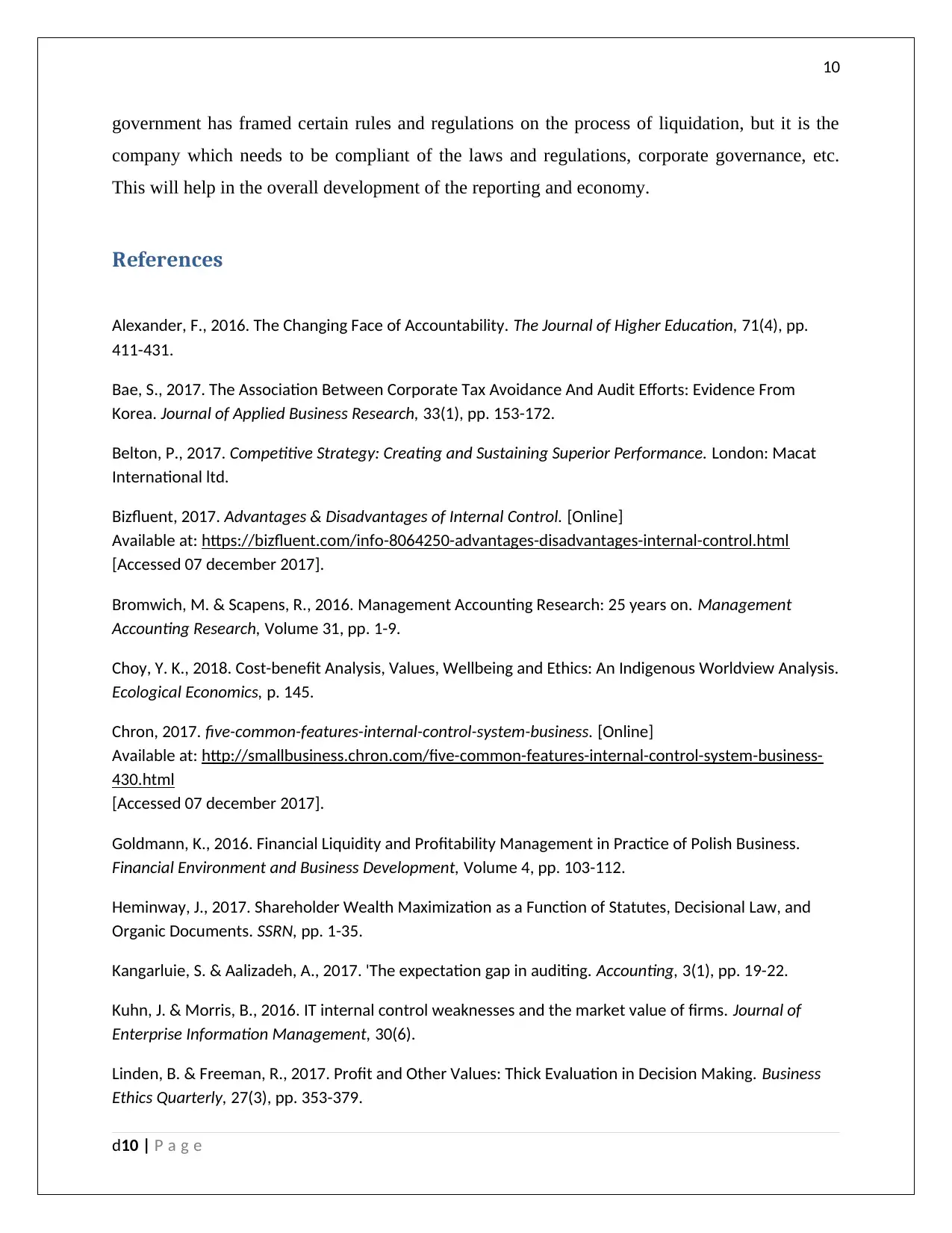
10
government has framed certain rules and regulations on the process of liquidation, but it is the
company which needs to be compliant of the laws and regulations, corporate governance, etc.
This will help in the overall development of the reporting and economy.
References
Alexander, F., 2016. The Changing Face of Accountability. The Journal of Higher Education, 71(4), pp.
411-431.
Bae, S., 2017. The Association Between Corporate Tax Avoidance And Audit Efforts: Evidence From
Korea. Journal of Applied Business Research, 33(1), pp. 153-172.
Belton, P., 2017. Competitive Strategy: Creating and Sustaining Superior Performance. London: Macat
International ltd.
Bizfluent, 2017. Advantages & Disadvantages of Internal Control. [Online]
Available at: https://bizfluent.com/info-8064250-advantages-disadvantages-internal-control.html
[Accessed 07 december 2017].
Bromwich, M. & Scapens, R., 2016. Management Accounting Research: 25 years on. Management
Accounting Research, Volume 31, pp. 1-9.
Choy, Y. K., 2018. Cost-benefit Analysis, Values, Wellbeing and Ethics: An Indigenous Worldview Analysis.
Ecological Economics, p. 145.
Chron, 2017. five-common-features-internal-control-system-business. [Online]
Available at: http://smallbusiness.chron.com/five-common-features-internal-control-system-business-
430.html
[Accessed 07 december 2017].
Goldmann, K., 2016. Financial Liquidity and Profitability Management in Practice of Polish Business.
Financial Environment and Business Development, Volume 4, pp. 103-112.
Heminway, J., 2017. Shareholder Wealth Maximization as a Function of Statutes, Decisional Law, and
Organic Documents. SSRN, pp. 1-35.
Kangarluie, S. & Aalizadeh, A., 2017. 'The expectation gap in auditing. Accounting, 3(1), pp. 19-22.
Kuhn, J. & Morris, B., 2016. IT internal control weaknesses and the market value of firms. Journal of
Enterprise Information Management, 30(6).
Linden, B. & Freeman, R., 2017. Profit and Other Values: Thick Evaluation in Decision Making. Business
Ethics Quarterly, 27(3), pp. 353-379.
d10 | P a g e
government has framed certain rules and regulations on the process of liquidation, but it is the
company which needs to be compliant of the laws and regulations, corporate governance, etc.
This will help in the overall development of the reporting and economy.
References
Alexander, F., 2016. The Changing Face of Accountability. The Journal of Higher Education, 71(4), pp.
411-431.
Bae, S., 2017. The Association Between Corporate Tax Avoidance And Audit Efforts: Evidence From
Korea. Journal of Applied Business Research, 33(1), pp. 153-172.
Belton, P., 2017. Competitive Strategy: Creating and Sustaining Superior Performance. London: Macat
International ltd.
Bizfluent, 2017. Advantages & Disadvantages of Internal Control. [Online]
Available at: https://bizfluent.com/info-8064250-advantages-disadvantages-internal-control.html
[Accessed 07 december 2017].
Bromwich, M. & Scapens, R., 2016. Management Accounting Research: 25 years on. Management
Accounting Research, Volume 31, pp. 1-9.
Choy, Y. K., 2018. Cost-benefit Analysis, Values, Wellbeing and Ethics: An Indigenous Worldview Analysis.
Ecological Economics, p. 145.
Chron, 2017. five-common-features-internal-control-system-business. [Online]
Available at: http://smallbusiness.chron.com/five-common-features-internal-control-system-business-
430.html
[Accessed 07 december 2017].
Goldmann, K., 2016. Financial Liquidity and Profitability Management in Practice of Polish Business.
Financial Environment and Business Development, Volume 4, pp. 103-112.
Heminway, J., 2017. Shareholder Wealth Maximization as a Function of Statutes, Decisional Law, and
Organic Documents. SSRN, pp. 1-35.
Kangarluie, S. & Aalizadeh, A., 2017. 'The expectation gap in auditing. Accounting, 3(1), pp. 19-22.
Kuhn, J. & Morris, B., 2016. IT internal control weaknesses and the market value of firms. Journal of
Enterprise Information Management, 30(6).
Linden, B. & Freeman, R., 2017. Profit and Other Values: Thick Evaluation in Decision Making. Business
Ethics Quarterly, 27(3), pp. 353-379.
d10 | P a g e
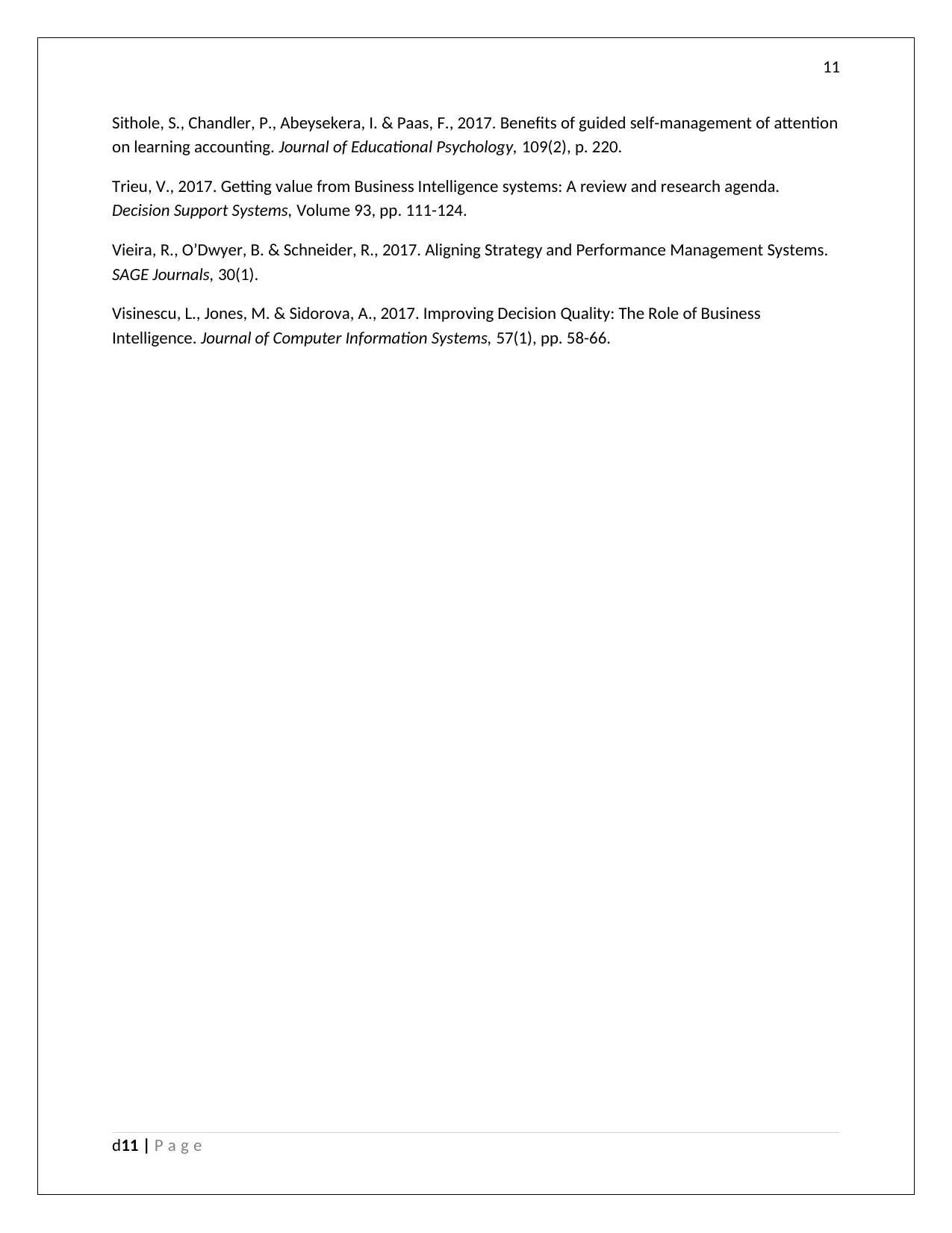
11
Sithole, S., Chandler, P., Abeysekera, I. & Paas, F., 2017. Benefits of guided self-management of attention
on learning accounting. Journal of Educational Psychology, 109(2), p. 220.
Trieu, V., 2017. Getting value from Business Intelligence systems: A review and research agenda.
Decision Support Systems, Volume 93, pp. 111-124.
Vieira, R., O’Dwyer, B. & Schneider, R., 2017. Aligning Strategy and Performance Management Systems.
SAGE Journals, 30(1).
Visinescu, L., Jones, M. & Sidorova, A., 2017. Improving Decision Quality: The Role of Business
Intelligence. Journal of Computer Information Systems, 57(1), pp. 58-66.
d11 | P a g e
Sithole, S., Chandler, P., Abeysekera, I. & Paas, F., 2017. Benefits of guided self-management of attention
on learning accounting. Journal of Educational Psychology, 109(2), p. 220.
Trieu, V., 2017. Getting value from Business Intelligence systems: A review and research agenda.
Decision Support Systems, Volume 93, pp. 111-124.
Vieira, R., O’Dwyer, B. & Schneider, R., 2017. Aligning Strategy and Performance Management Systems.
SAGE Journals, 30(1).
Visinescu, L., Jones, M. & Sidorova, A., 2017. Improving Decision Quality: The Role of Business
Intelligence. Journal of Computer Information Systems, 57(1), pp. 58-66.
d11 | P a g e
⊘ This is a preview!⊘
Do you want full access?
Subscribe today to unlock all pages.

Trusted by 1+ million students worldwide
1 out of 12
Related Documents
Your All-in-One AI-Powered Toolkit for Academic Success.
+13062052269
info@desklib.com
Available 24*7 on WhatsApp / Email
![[object Object]](/_next/static/media/star-bottom.7253800d.svg)
Unlock your academic potential
Copyright © 2020–2025 A2Z Services. All Rights Reserved. Developed and managed by ZUCOL.





